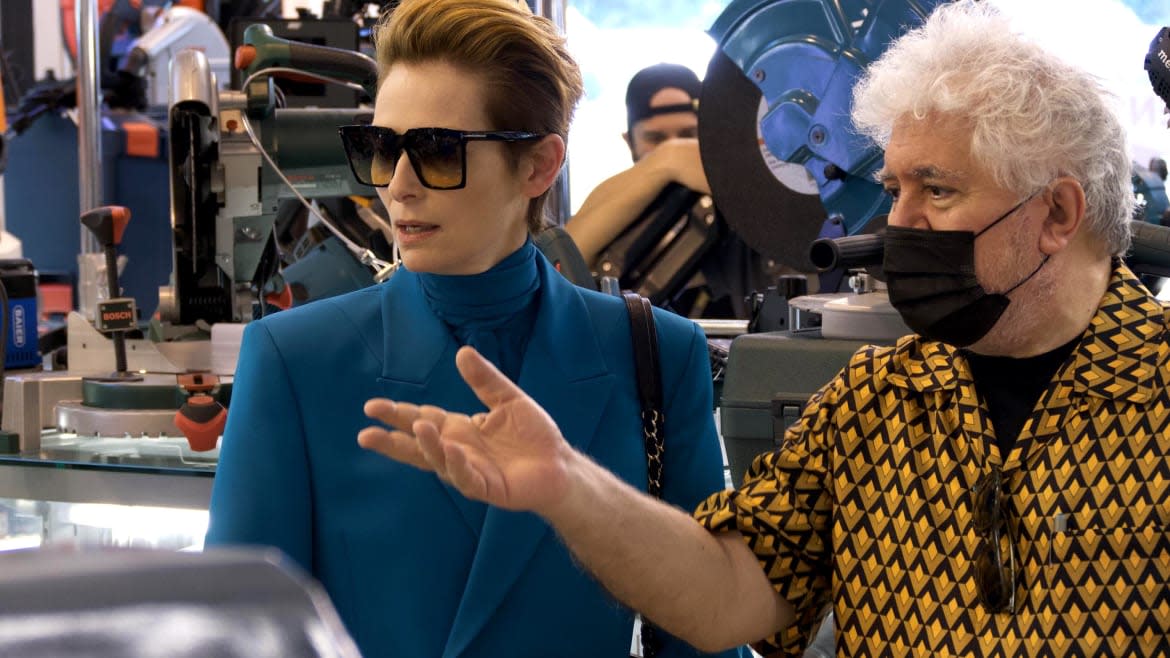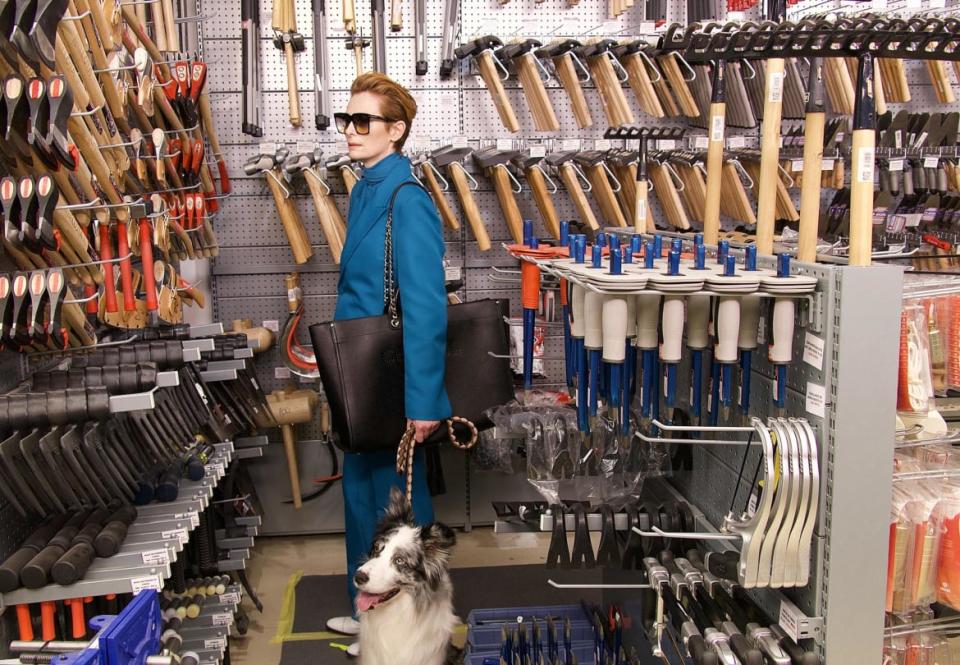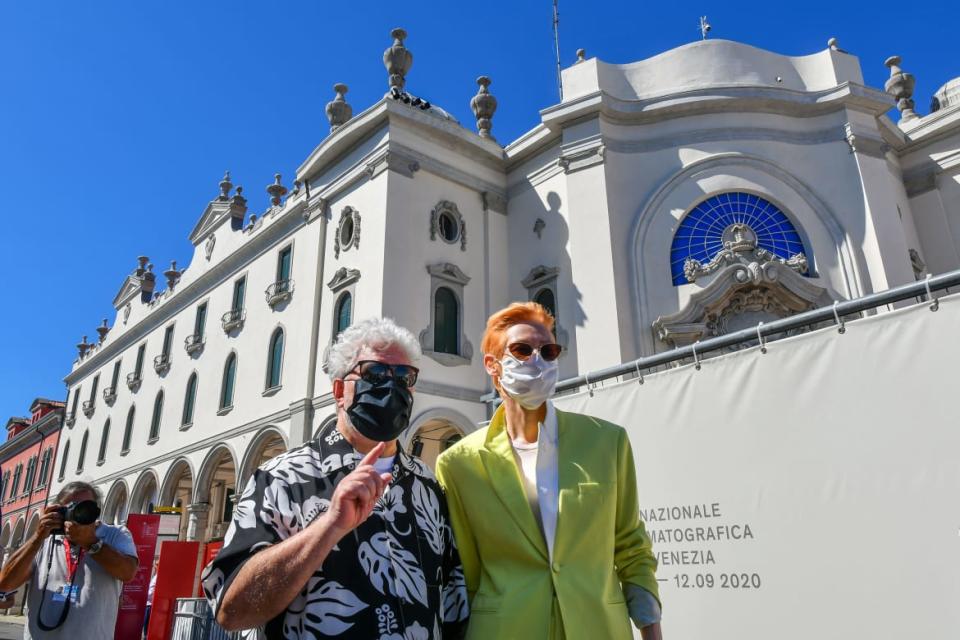Pedro Almodóvar and Tilda Swinton on Their Pandemic Triumph ‘The Human Voice’

- Oops!Something went wrong.Please try again later.
- Oops!Something went wrong.Please try again later.
- Oops!Something went wrong.Please try again later.
Seemingly immune to the pandemic blues, Spanish master Pedro Almodóvar has kept incessantly busy. “I don’t how to live on vacation. This is my life,” he tells me over the phone while in a moving vehicle traveling across his homeland’s countryside. This transfer between locations is the only time he could allocate to chat. The tireless auteur—patron saint of complicated mothers, heartbroken women, and male eroticism—is currently in pre-production on his upcoming feature, Madres paralelas, starring recurrent muse Penélope Cruz.
Foregoing the on-camera ritual of a Zoom video call, which has become the norm for interviews over the past year, only our spoken words in Spanish are perceptible to each other—for better, and, as it was later proven, for worse. This mode of communication that his availability has inflicted on us seems fitting to discuss The Human Voice, his new short film and first foray into English-language storytelling.
With the astonishingly versatile British actress Tilda Swinton as his sole talent for most of this half-hour work, Almodóvar revisits Jean Cocteau’s one-actor stage play of the same name. The 1930s source material was previously inserted in the director’s early film Law of Desire through Carmen Maura, and later was the basis for his international breakthrough Women on the Verge of a Nervous Breakdown.
Our Oscar Nomination Picks: Who Should Be Nominated
“I’ve been passionate about Cocteau, in all his facets, since I was very young,” Almodóvar says of the multidisciplinary artist whose drawings of teenagers and filmic projects marked him.
His fascination with the monodrama about an emotionally ravaged woman on a call with a lover ending their affair is also grounded in his adoration for the great goddesses of the big screen and the trauma of romantic desertion.
“I love actresses, and this is an iconic piece for iconic divas,” he explains. “What I like about him and this text is the excess that is purely melodramatic, but that, because of his talent as a writer, acquires a style that’s superior to melodrama. Abandonment is also a dramatic element that has always interested me. An abandoned woman is a bomb that can blow up at any time. In my films there is more than one abandoned woman, fueled to recover the person she loves, to change her life, or to overcome their situation.”
Over the years, Cocteau’s The Human Voice has been embodied in cinema and on the stage by great thespians such as Anna Magnani for Roberto Rossellini’s L’Amore, by Ingrid Bergman for a Broadway production directed by Ted Kotcheff, or in France by Simone Signoret. Now Tilda Swinton joins that list in this new reinterpretation, which is currently shortlisted for an Oscar in the Live Action Short Film category.

Tilda Swinton in The Human Voice
Despite having flirted extensively with it early in his career, Almodóvar still felt he hadn’t been truly faithful to Cocteau’s elegant diatribe and wanted to make it closer to its normal duration: between 25 and 30 minutes. “I wanted to get closer to what this theatrical piece is as literature. With that disposition I sat down to adapt it. In doing that, I discovered something I wasn’t conscious of 30 years ago, which is that I didn’t recognize myself in the character’s submissiveness, with the guilt she carries. In Cocteau’s piece the character constantly blames herself,” he notes.
To address that disconnect, he began the reconfiguration by embracing its theatricality while incorporating what he believes Cocteau himself would have integrated today: a more contemporary, outspoken woman who defends her positions.
“From a personal standpoint, I really empathized with the character and that’s why I wasn’t willing to let her be caught in vicious circles around the monologue and staying inside the studio where we shot the piece. She asked me to free her from her suffering and let her start a new life. That’s a small betrayal to the original text, but it was a way to make it current, especially at a time in which women, though there are still many issues to solve, have plenty more freedom than back when Cocteau wrote it,” says Almodóvar.
In brilliant meta fashion, Swinton plays an actress mourning the loss alone, until the phone rings and she begins a dialogue with the perpetrator of her suffering on the other side. Dressed in full hard-to-ignore Balenciaga regalia, which the actress describes as “crying out for their moment in Pedro’s world”—a red turtleneck, an aquamarine suit, or a velvet devoré dressing gown—she delivers a verbal potion made of vitriol, despair, and eventually vengefulness. To look away from her presence is an impossibility. Swinton on a painful call is as intensely captivating as it sounds.
The only time we see her outside her meticulously decorated home is in a hardware store (where Agustín Almodóvar, the director’s brother and producer, serves as clerk). Tools for bludgeoning play a candid role here. “Almost all the objects inside a hardware store can be lethal if you used them with that intention. A hatchet can put things in their place,” says the director mischievously. For Swinton, entering the mind of the venerated Spanish sensualist was a breathtaking experience.
“I’ve had the privilege several times in my life of stepping into a frame the signature of which I already know very well—Béla Tarr’s, for example, or Wes Anderson’s or Apichatpong Weerasethakul’s—and it’s a trip. It’s a piece of imaginative work to get over the sense of virtual reality... In Pedro’s case, his colours, his environments, his gestures, his people are so recognisable, so particular, that I found it a special leap of faith to bring myself over the threshold,” Swinton says via email.
“In this film, the portrait is of a woman pretty distinctly different in rhythm from me: she is a capital A Actress with a sense of artifice and display which is quite a ledge for me to step up onto... In this respect I was very keenly dependent on Pedro’s instincts, and his proper, reliable sense of direction... The task was to reach that performative ledge while at the same time being as relaxed and open as possible… it would have been unimaginable without the sureness of Pedro’s energy... and the confidence that his cinema is a state of its own with its own laws and landscape. It’s a bit like learning to sing a song you love and getting used to hearing it in your own voice,” she adds.
The space Swinton inhabits in The Human Voice exists between the mediums of film and theater. At first glance the place is a soundstage, dark and utilitarian, but within it there’s a set that simulates an apartment. This is, clearly, not just any residence, but one that exudes Almodóvar’s signature color palette and even features books and DVDs that almost certainly belong to the artist himself. From the opening scenes, Almodóvar makes us aware of how he is playing with our perception based on this realm, where the limits between movie magic and performance art, and between theatrically and restraint fluctuate.
“This was one of the reasons for making the short. The first images that came to my mind were of a woman completely alone, isolated in a place waiting for a call. I wanted to mix what’s essentially theatrical which is the interior where she lives, with something essentially cinematic, and I wanted both things to be unified,” offers Almodóvar.
Meanwhile, Swinton felt the hand of filmmaking had a stronger grasp throughout the production.
“I haven’t worked in the theatre for over two decades and have no real understanding of or investment in its mechanisms, to be honest. But I never felt the pull of a theatrical context in this film. The entire landscape of the piece is bound up in the atmosphere of a crucial vacuum, a lack of the attention of an audience, the very thing on which theatre relies. Quite to the contrary, this film always felt to me exceptionally related to cinema: its reference to self-reflection and the contained discipline of its life within each frame. In terms of live performance, my sense was more that Pedro was touching the pulse of dance—or even opera or the great art form of the torch song—rather than that of the theatre,” says Swinton.
In Almodóvar’s eyes, Swinton’s actress is an individual trapped threefold, and everything that accompanies her in that desolate mental state contributes to her devastation. From the Caravaggio-like painting Venus and Cupid by Artemisia Gentileschi to the terrace that’s almost identical to the one in Women on the Verge and has a similar dramatic function.
“She is drowning inside the walls of the passion she feels for her lover. That’s the most important prison, from which she is unable to escape. Then she is also confined in that apartment in which she can’t stop walking around in circles like a crazy person, and then once I take her out of there and I show the structure of the apartment she continues to be confined inside a much larger place: the studio where we shot,” says the filmmaker. “It’s curious that even though I wrote it just before the pandemic, the fact that we shot it during the pandemic created in us a sort of conscience that there was something metaphorical in the total isolation of this woman, and that resonated with the reality that surrounded us.”
The global COVID-19 crisis didn't slow Almodóvar down at all. “I haven’t stopped. Over the course of the last year, opposite to what happened in Spain and the rest of the world, it’s been one of the most active periods ever for me. I haven’t taken a breath,” he says.

Pedro Almodóvar and Tilda Swinton at the 77th Venice Film Festival on September 3, 2020, in Venice, Italy.
Almodóvar returned to Spain in late February 2020, following the Academy Awards where his last feature Pain and Glory, with Antonio Banderas as lead, was nominated for Best International Feature film. Days after landing back home, Swinton visited him for a week to formally begin constructing their collaboration, rehearsing and doing table readings. But just a week after their rendezvous, Spain went into lockdown and they had to stop preparing The Human Voice. Unknowingly, the director had contracted the virus.
“During the first week of confinement I had COVID, but it was very gentle, let’s say. I didn’t have to go to the hospital. Once I got over the illness, I started writing. Writing was the only way of making sense of loneliness, isolation, lack of contact with friends, or going out for dinner, or to the cinema. Fortunately, that situation, far from distressing me, allowed me to concentrate intensely in the writing. And when the lockdown ended and we restarted working on The Human Voice, I already had the screenplay for a new feature film, which is the one we are preparing right now, and just about to start shooting,” he shares.
Almodóvar deliberately set out to make his English-language debut with The Human Voice, and credits Swinton with helping make that linguistic jump happen. Although they didn’t have an intimate friendship prior to this partnership, the two had always been mutually effusive when crossing paths at festivals or awards ceremonies. He held the belief that she was on his artistic wavelength and this confirmed it.
“English is not my tongue. I don’t dominate it. I didn’t know if I would be capable of explaining to the actors what I wanted. I talk a lot with the actors, and I do a lot of rehearsals. I wasn’t sure I would be able to express myself sufficiently for the actors to understand me. But working with Tilda on this short, I’ve lost 50 percent of that fear,” he says.
Jesse Williams on Facing ‘Frightening’ Racism in Tech and His BET Awards Backlash
Swinton, for her part, vividly remembers her first encounter with Almodóvar’s vibrant frames and is able to paint a detailed picture of what that moment of discovery evoked.
“The first film of Pedro’s I saw was Women on the Verge of a Nervous Breakdown. I remember seeing Women on the Verge of a Nervous Breakdown and feeling this enormous sense of relief. Here was a filmmaker making films about Europe and about people and a milieu that I recognised entirely—and at the same time, a contemporary artist whose reference to the cultural landscape of cinema makes him heir to so many great directors through film history, especially those great masters who have focused their narratives and their atmosphere on the lives and passions of women,” recalls Swinton. “Pedro was putting onto a global screen a sensibility and a vernacular which was close to the underground world I was living in with Derek Jarman in London in the ’80s and early ’90s. He was always our Spanish cousin, very dear and greatly cherished as a fellow traveller with brilliant moves.”
To finish on a note of closure, I ask Almodóvar about the endings of his movies and whether he believes in neatly wrapped joy or if he runs from that sense of full gratification.
“Sometimes I think of an ending and then I change it according to how the story develops. The story at some point acquires autonomy, and you shouldn’t lie to yourself or lie to the audience. At this point in my career, I no longer posses the naiveté to impose a happy ending on my stories,” he explains. “In The Human Voice, I did it because the character herself was asking me to do so. As an author I felt obliged to liberate her. In general, I try to leave the endings open-ended, but also for my characters to always be in a better place when the movie ends than where they were when the movie started.”
Get our top stories in your inbox every day. Sign up now!
Daily Beast Membership: Beast Inside goes deeper on the stories that matter to you. Learn more.

